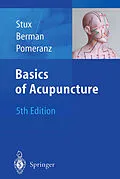A book for Practioners!
- A synthesis of Western science and medicine with traditional Chinese Concepts
- Easy-to-read introduction to the philosophy and theory of traditional Chinese medicine
- The most important acupuncture points, systems of channels and functional organs
- Technique of Acupuncture, Moxibustion, Acupressure, Laser Acupuncture...
- How to treat diseases, based on Western modes of diagnosis
Autorentext
Dr. Gabriel Stux, MD Acupuncture since 1977 in China, Sri Lanka, India Founder and Chairman of the German Acupuncture Society, Düsseldorf, 1978, Lectures on Acupuncture all over the world for more than 20 years Introduction of a new energy medicine, called Chakren Acupuncture in 1988
Dr. Brian Berman, MD, Professor Founder and Director of the University of Maryland Complementary Medicine Program (CMP), 1991 Professor of Familiy Medicine, trained in acupuncture, homeopathiy and other CAM-approaches Principal Investigator of a NIH center grant for compementary medicine research International Seirin award for his contributions to the scientific understanding of acupuncture Chair of the steering committee of the Consortium of Academical Medical Centers whose mission is to promote integrative medicine Co-Chair of the editorial board of the report to the NIH: Alternative Medicine: Expanding Medical Horizons Coordinator of the Complementary Medicine Field of the international Cochrane Collaboration
Dr. Bruce Pomeranz, MD, PhD MD and CM at McGill University 1961, PhD at Harvard 1967 University of Toronto, Professor of Zoology and Physiology Assistant Professor at M.I.T 1966-1968
Klappentext
Basics of Acupuncture shows that it is possible to combine Western medicine with traditional Chinese concepts. A short introduction on the theory of traditional Chinese medicine is followed by a detailed account of diagnosis. The main part focuses on the description of the Chinese systems of channels, functional organs and the most important acupuncture points. The remainder of the book is devoted to treatment, based on western modes of diagnosis. The methods and applications of needling and moxibustion are described, and the most important points are given for frequently encountered diseases.
Inhalt
2 Scientific Basis of Acupuncture.- 3 Background and Theory of Traditional Chinese Medicine.- Channels, Organs, and Points.- Technique of Acupuncture.- Acupuncture Treatment.- Electroacupuncture and Transcutaneous Electrical Nerve Stimulation.- Additional Methods of Treatment.- Appendixes A-D.
